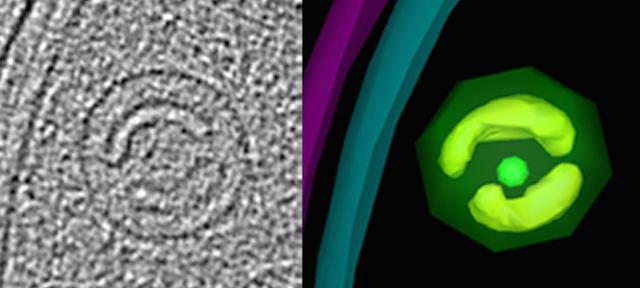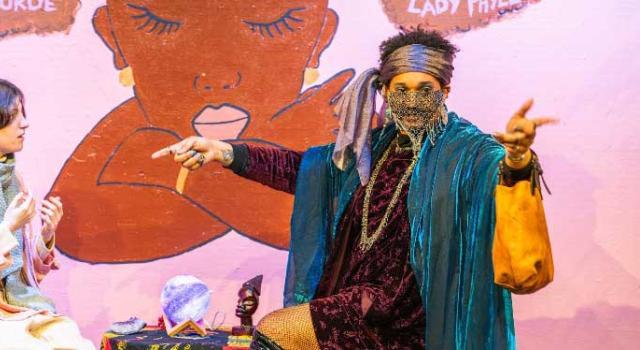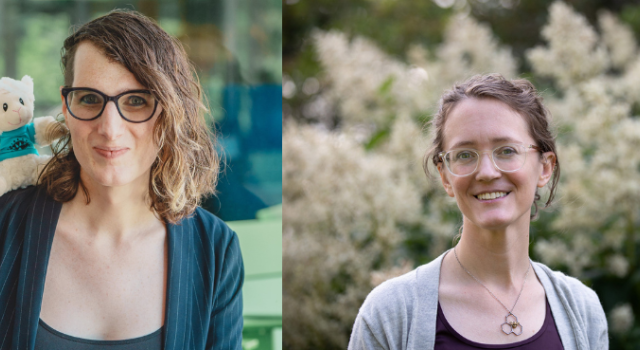'What Are Those Alien Things In Bacteria?' Professor Dobro and Team of Scientists and Students Publish Discoveries

A team of international researchers on a project organized by Hampshire College Assistant Professor Megan Dobro and Caltech Principal Investigator Grant Jensen has recorded never-before-seen structures in bacteria and published its findings in the Journal of Bacteriology, from the American Society for Microbiology. The discovery and recording of these macromolecular structures is groundbreaking because, in Dobro's words, "bacteria are the most abundant life-forms on Earth, and we are now moving toward a comprehensive list of parts inside bacteria. This will help us one day be able to control those that impact human health, and maybe even create our own to solve some of humanity’s biggest problems."
Beginning in 2014, Dobro and the team of scientists and student research assistants from Hampshire, Caltech and nine other institutions internationally conducted a microscopy survey of 3D electron cryotomograms of 88 species of bacteria, producing 3D views of macromolecules in cells. The 15,000 images reside in a database at Caltech's Jensen Lab.
Among the 88 species, the team recorded structures in some bacteria that affect human health, including those that cause cholera, gastric ulcers, food poisoning, the sexually transmitted infection chlamydia, and Lyme disease. Most bacteria are actually helpful to humans, she says: “Gut bacteria help us digest food, provide Vitamin K, improve nutrient absorption, and strengthen our immune system,” for example.
Dobro was featured today describing this research on The Academic Minute radio segment, distributed on WAMC and other stations, InsideHigherEd.com, and elsewhere on the Web. https://academicminute.org/2017/08/megan-dobro-hampshire-college-bacteria/.
Listen to the Academic Minute segment:
[Read the published research http://jb.asm.org/content/early/2017/06/07/JB.00100-17 and http://resolver.caltech.edu/CaltechAUTHORS:20170616-093425610]
Dobro and her team found structures in bacteria that are shaped like twisted filaments, chains, railroad tracks, tubes, discs, and horseshoes. A structure in one species was covered in protruding appendages that look like the Eiffel tower with antennae. Another had thin hooks covering the surface, a third had dense hairlike fibers growing at one end.
The team produced full tomographic (3D) videos of each feature, available for public viewing at https://figshare.com/s/782461843c3150d27cfa.
Two Hampshire students were involved in this research. Most recently, Aidan Piper, who graduated in May 2016, worked on this project for his Division III thesis, titled “Digital Modeling through Novel Technological Methods.” He constructed 3D models of these structures recorded through microscopy and displayed them using unusual technologies, among them stereolithographic 3D printing and digital holography.
Piper proposes that these technologies can help researchers better understand 3D structures and help students learn biology in a more engaging way. And Dobro agrees the 3D modeling of macromolecular structures will help scientists better educate and interest students in science.
Piper also wrote a smartphone app to view these structures with virtual reality goggles. The figures can be viewed in virtual reality at https://play.google.com/store/apps/details?id=com.BishopVisual.Mk2&rdid=com.BishopVisual.Mk2.
In December 2015, he presented his research at the American Society for Cell Biology conference, in San Diego, as a poster session titled “Stereoscopic 3D visualization of cellular ultrastructure through smartphone-enabled virtual reality.”
Dobro believes the publication of the team’s research in the Journal of Bacteriology may be the first scientific paper incorporating 3D virtual-reality imagery. She says Piper has now founded a start-up in Boston related to the skills he developed.
Another student, John Cohen 11F, also worked on this project for his Division III and traveled with Dobro to CalTech as a member of the original team that discovered the structures. As part of his Div III, Cohen also created digital models of structures he found. Both students are among those listed as published authors on the research.
This research is one of the first significant projects to utilize Hampshire’s new Collaborative Modeling Center, a dedicated, state-of-the-art facility outfitted with lab equipment, modeling software, a 3D printer, high-definition projection screens, tablets, physical modeling accessories, and collaborative work spaces. [Read more at https://www.hampshire.edu/news/2016/12/01/hampshire-opens-advanced-coll…]
PARTNERSHIP WITH CALTECH
Dobro performed the research in collaboration with her former PhD adviser Grant Jensen at Caltech’s Jensen Lab, using the powerful cryo-electron microscope there. In electron cryotomography (ECT), cells are plunge-frozen into a mixture of liquid ethane and propane, a technique so rapid that it preserves cellular structure. Samples are subsequently imaged in the transmission electron microscope as they are tilted one or two degrees at a time. This results in a series of projection images that can be digitally reconstructed into a 3-D tomogram of the cell, much like a CT scan in medical care. Resolution of relatively thin biological samples is ~4-6 nm, and some structures can be captured at a resolution better than 1 nm. ECT is enabling scientists to study structures of individual proteins in cells and cellular macrostructure.
Electron cryotomography captures images of bacteria in three dimensions at high resolution, says Dobro, “enabling us to see the tiniest machines in great detail. This method has given scientists a more complete picture of important structures inside bacteria, from powerful motors that allow bacteria to swim, to magnetic compasses that guide them, to toxin-tipped weapons used by the bacteria.”
“In talking with Grant,” she remembers, “we realized there are a lot of structures seen over the years in Caltech’s database of macromolecular images that weren’t catalogued because they weren’t the purpose of the project at the time.”
Dobro’s team compared the structures across species of bacteria and recognized that they were repeating structures and therefore significant.
Some of these objects are being recorded for the first time. For other objects, it's the first time they've been classified into groups and cataloged in bacterial species.
“What’s most exciting for me is learning how complex bacteria are,” Dobro says. “People think of bacteria as simple structures but they’re more complicated than we thought. There are structures in bacteria that are beautiful and complex. What are these alien things doing in bacteria?”
Dobro will be teaching about the team’s research in her new fall course, NS 346 Microscopes and Modeling.
INSTITUTIONS REPRESENTED
The research scientists in the study represent the following institutions:
- Hampshire College
- California Institute of Technology
- City of Hope, California
- ETH Zurich, Switzerland
- Howard Hughes Medical Institute, Pasadena
- Leiden University, the Netherlands
- National University of Singapore
- Rosalind Franklin University of Medicine and Science, Chicago
- Université de Montréal
- University at Albany, SUNY
- University of Southern Denmark
ADDITIONAL PRESS COVERAGE
Phys.org news service: https://phys.org/news/2017-06-bacteria-function.html
ScienceNews magazine https://www.sciencenews.org/article/scientists-spy-secret-inner-life-bacteria
Science Daily https://www.sciencedaily.com/releases/2017/06/170613163324.htm
MEGAN DOBRO'S FACULTY PROFILE
https://www.hampshire.edu/faculty/megan-dobro
GALLERY



